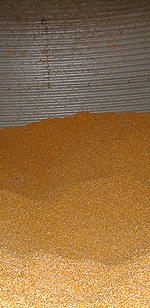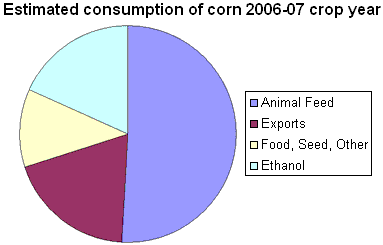



Stakes rising as Biofuels consume global commodity stocks faster than production is rising
TheCattleSite Editorial - An unprecedented period of commodity volatility is upon us as corn prices rose above US$4 per bushel (March 07 delivery) for the first time in a decade last week, this time it seems that the point of inflection could have been passed setting the long term market to high or rising.
What of the price of corn?
When President George W. Bush pressed for even faster growth in the production of ethanol in his State of the Union address last week he was also issuing the clearest of signals to a truly global audience that the era of cheap food is now over.
President Bush may be more a convert to reducing the US dependency of foreign oil than he is to averting the impending disaster of global warming where presidential sceptiscism has yet to be troubled by exposure to the facts.
However that bears little on the outcome as, whatever the exact reasoning, the foot has hit the floor on converting to Biofuels and with Iowa the first state in the presidential electoral round, who would bet on this administration performing a u-turn on a policy that is revolutionising the economic outlook for the voters in the number one corn growing state.
To evaluate what happens next it is worth reviewing how the situation is poised on some key economic drivers:
World grain stocks low
With stocks already at a 30 year low neither upward demand, or downward supply volatility will be taken up from inventory. The commodities markets are also attracting new players as hedge funds and speculators see increased volatility as increased opportunity, so it is reasonable to expect sharper reactions to supply and demand changes with consequently sharply heightened risk for consumers.
Increased production of corn
The price of corn has risen fast, up 5% last month and more than 50% on a year ago, catching many growers on the hop for this year’s plantings, as a result acreages actually declined 5% to 70 million acres as farmers switched into soybeans, wheat and cotton. USDA predicts 2006-7 production at 10,535 million bushels, against 11,114 last year and 11,807 in 2004-5.
Ethanol is now taking 19% of US corn and has become the prime driver of corn utilisation with 110 plants in production and another 73 in construction taking an estimated 3 billion bushels of corn to produce 6 billion gallons (23 billion litres) of ethanol in 2007. With the additional plants already being planned this number will quickly pass 200 and the consumption of corn for ethanol could double in less than 10 years consuming another 12-15 million acres. If this seems ambitious lets not forget that the growth in ethanol has been consistently underestimated in every serious assessment so far!
| Projected Corn Production | |||
| Crop year: | 2006-7 | 2007-8 | 2008-9 |
| Acres in production (million) | 70 | 80 | 85 |
| Yield (bushels/acre) | 149 | 152 | 153 |
| Production (million bushels) | 10,535 | 12,150 | 13,000 |
| Source: NCFC | |||
Even if marginal land is pulled back into production, and there is some slackening on weed/conservation land pulling in perhaps 3-5million acres the growth in corn production can still only be managed at the expense of substantial substitution of soya and other crops, with rises in the price of these as a consequence. Analysts agree that although it is possible to envisage the shift in land use necessary to fuel this growth without spiralling cost this is based on some uncomfortable assumptions;
-
That the high corn yields of over 150 bushels/acre that the USDA projection assumes are consistently achieved. If there is any significant drought, and with ever more pessimistic predictions coming from climatologists on all sides about the rate of climate change it would be brave, if not foolhardy, to rule drought out, then the loss in yield would mean that all bets are off. If the 12 billion bushel crop needed meet to meet the projected 2007-8 demand is not achieved then upward price elasticity will be significantly tested at an early stage.
-
That exports will not significantly increase exerting new pressure on the market. Corn exports have not risen in line with Soya (and cotton) which have been heavily driven by China who now take over 45% of US exports. However growth is starting to appear from other countries seeking corn to fuel their own ethanol production – if this growth holds or accelerates then the impact on the market will be dramatic. Dr Terry Barr, respected Chief Economist at the National council of Farmers Coops, speaking at IPE in Atlanta last week put it this way “it may be true that the world can no longer count on the US for its corn and soya supply – but serious players like the Chinese are not going to just walk away from their vital raw material supplies without a fight……… and some people may be surprised by how much these buyers can afford to pay to stay in”. In addition Dr Barr reminded his audience of concerned poultry producers that the US economy is growing slowly at around 2% and both government and consumers continue to take on debt weakening the dollar and providing additional support to the overseas buyer.
-
That the oil price will not start heading back up towards the US$65-70+ barrel price range recently experienced. On the face of it this seems a reasonable bet however oil rose more than 2% to top US$55 a barrel on Friday as unusually warm weather in the US Northeast appears to have come to an end triggering an expected rise in heating oil demand. In addition the OPEC cuts in production are reducing the surplus and a risk premium is being reintroduced as a result of growing political tensions between the US and Iran. Oil price stability is hard to foresee and whilst it is also true that a period of below US$50/barrel oil prices would take some of the heat out of ethanol growth we need to keep in mind that the current tax break and cost of production climate make it possible for ethanol producers to turn a profit on corn at well over a dollar a bushel above any other user!
-
That the pork and poultry industries, who will be hardest hit by the cost of corn and who, unlike cattlemen cannot use the low cost byproducts of ethanol fermentation (DDGS - dried distillers grains with solubles) to offset the rising feed cost, will seek to limit output in order to raise prices at the same time taking the edge off demand for animal feed. This also seems to be a reasonable assumption but there is no certainty here, the livestock industries have not always been so predictable and their internal competitive dynamics have often proved to be the most powerful driver of their production.

Source: USDA, American Farm Bureau Federation.
Impact of new technology
There are a number of interesting and highly pertinent questions unanswered, not least of which is the impact that new technology will have on all this. This is particularly important to those considering how long corn will remain the standard bearer of green energy? The answer may be not so long, Bio-diesel is taking off in Sweden, Germany, and other parts of Europe (even the laggard Brits are starting to consider this seriously) as it is seen by many as more flexible and easier to handle than ethanol plus importantly it requires much lower capital at the processing stage. The byproduct can be simply processed to allow it to enter pig and poultry diets and there are already many looking at this with soya and /or rape (canola) as the raw material. If Bio-diesel does take off it will hardly ease the pressure on commodity prices but it will help spread the risk.
The second major question is how long before the technology allows us to efficiently feed other bulk lower feed value raw materials into ethanol fermentation. Technical innovations are being developed for the production of cellulosic ethanol however there is a predicted 3+ year wait before commercial scale fermentation can have any impact on the market.
A third area where new technology can play an important role is in improving the nutritional value of DDGS which is both a highly variable product and one where any mycotoxins present will tend to be concentrated. Dr Pearse Lyons, whose company Alltech has been developing technologies to address these problems believes that there is a key role for secondary fermentation in tackling these issues. He states that “Through solid state fermentation (SSF) we can grow organisms on DDGS that will give us a more consistent and higher quality feed source” Lyons argues that this together with a structured approach to mycotoxins analysis and the use of control agents offers real potential. “There is no safe level of mycotoxins in feed, also they seem to work in synergy thus compounding their negative effects” says Lyons who firmly believes that tackling mycotoxins at source is a key part of the DDGS story.
More winners than losers but also more risk
Whilst some prominent analysts in the US have stated that high corn prices will have little effect on economic fundamentals and inflation this seems to many short sighted since corn prices are already exerting an upward pull on other commodities. In addition some retail buyers are already signalling that where the raw materials markets are driving up costs then price increases have to be expected and there are those who see higher prices at the till and consequent improved yield per unit of shelf space as the best strategy for profit growth – as long the underlying cost dynamics are the same for all.
It seems clear that the farmers and food producers can expect a substantially different economic outlook from here on, and it would seem that there are already clear winners emerging, not just those who grow the crops but also their equipment suppliers and in all probability livestock producers too once the retail price adjusts to the raw material cost. The slowest to see this change could be the beef sector where both US production and inventory remain strong but outside the US the market is tighter and this is expected to pull through into higher prices.
However increased commodity market volatility together with rising interest rates, and higher fertilizer/input costs mean that the risks of holding stock and forward trading are much greater – this is not going to be a smooth ride.
Finally there remains the little matter of end consumer expectation of a continuing decline in the real cost of food. Well as one major chicken producer at IPE said “when it comes to dealing with consumer expectation I’m happy to leave that to the politicians after all they created the situation”
TheCattleSite Editorial - January 2007


